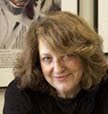
"Storytellers broaden our minds: engage, provoke, inspire, and ultimately, connect us." — Robert Redford
One of the films making the Sundance Film Festival this year is !War (!Women Art Revolution), which elaborates on the relationship of the Feminist Art Movement and the 1960s anti-war and civil rights movements. The film then expands into major developments throughout the 1970s.
Much like Redford said about independent storytellers, the documentary by director Lynn Hershman Leeson re-raises the issue of women's role in art, providing a glimpse into hundreds of hours of interviews with visionary artists, historians, curators and critics that Hershman Leeson collected over 40 years. Her own art is held in numerous collections, including at the Museum of Modern Art (New York), the National Gallery of Canada, DG Bank (Frankfurt) and the Walker Art Center (Minneapolis).
Along with the art, Hershman Leeson sets the footage to music contributed by women musicians such as Laurie Anderson, Janis Joplin, Sleater-Kinney, The Gossip, Erase Errata, and Tribe 8. The film has also been used to raise funds for the San Francisco Art Institute.
"One day seven years ago I found myself saying to myself–I can’t live where I want to–I can’t go where I want to go–I can’t do what I want to–I can’t even say what I want to–...I decided I was a very stupid fool not to at least paint as I wanted to." — Georgia O’Keeffe, 1923
While the film paints a pivotal feminist art revolution that is often overlooked in a historical significance in the 1960s and 1970s, there have been several movements to unshackle women from conformity. As late as the 1900s, women were limited to specific styles such as portraits, still life, and domestic subjects.
 According to the National Museum Of Women In The Arts (NMWA), there was a time when women had to advocate for the right to render any nude figure, a subject previously restricted to male artists. When they were finally allowed, several female artists reinvented the monumental female nude as a strong "new woman" rather than the sexualized object of male desire.
According to the National Museum Of Women In The Arts (NMWA), there was a time when women had to advocate for the right to render any nude figure, a subject previously restricted to male artists. When they were finally allowed, several female artists reinvented the monumental female nude as a strong "new woman" rather than the sexualized object of male desire. Artists Suzanne Valadon and Lotte Laserstein, specifically, are credited with leading the way. But before women won this freedom of expression, they were often forced to confine themselves to domestic subjects. Valadon became the first woman painter admitted to the Société Nationale des Beaux-Arts. Laserstein was a German artist whose greatest work was completed in the period between the two world wars.
The NMWA, located in Washington D.C., has a permanent collection that includes more than 3,000 works of art by women from the 16th century to the present. It also provides extensive educational programs that trace women in the arts from the 1600s. Currently, the museum is exhibiting a selection of nearly 30 photographs and sculptures called P(art)ners: Gifts from the Heather and Tony Podesta Collection through March 6.
!Women Art Revolution Is A Liquid Hip Good Will Pick.
 At least once a month, Liquid [Hip] highlights good will efforts undertaken by courageous people with big hearts. We don’t score them. That belongs to you.
At least once a month, Liquid [Hip] highlights good will efforts undertaken by courageous people with big hearts. We don’t score them. That belongs to you. If you would like to help, the producers of !Women Art Revolution request donations for the San Francisco Art Institute, one of the oldest and most prestigious schools of higher education in contemporary art. You can donate through the film site or direct. !War has yet to be released for home entertainment, but periodically lists limited showings around the United States.
Or, consider supporting the NMWA, which is the only museum in the world dedicated exclusively to recognizing the contributions of women artists. Interestingly enough, Wilhelmina Cole Holladay and Wallace F. Holladay began collecting art in the 1960s when scholars and historians began discussing the underrepresentation of women in museum collections and major art exhibitions.
![Liquid [Hip]](https://blogger.googleusercontent.com/img/b/R29vZ2xl/AVvXsEjAFBQPqS7J0-rrttNoRYSsuwIePPZf4Nq6sqDioK1zzVQXJIQXKzq_NVNI4n6h3inuRQFBKOcJeZeSufkdHHIOxbSWyBjTjTxgKEQGyPzdwvkEEeECh4bI5YEGk4RWGUINSd7vulPQsCA/s1600-r/liquidhip.jpg)